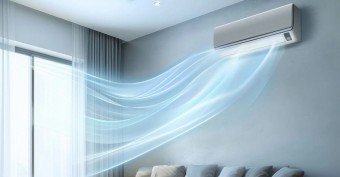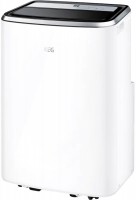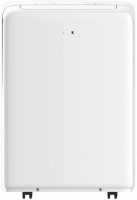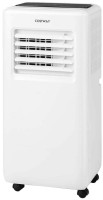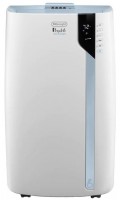How to choose a mobile air conditioner?
We independently test the products and technologies that we recommend.

Mobile or portable air conditioners are compact monoblock devices up to 80 cm high, outwardly similar to lockers. One of the main advantages over classic split systems is that they do not need expensive installation. By and large, to start using the device, you just need to remove it from the box, connect it to the power supply network and bring the hose out through an open window, door or a specially prepared hole for this.
Most often, mobile air conditioners are used in cases where the installation of a stationary split system doesn't make sense. For example, if it is necessary to provide cooling in temporary premises or where people live only seasonally. It can serve as an excellent solution for buildings of historical, artistic or architectural value when the installation of external blocks from the outside is prohibited. When organizing temporary retail premises, the use of a mobile air conditioner will attract customers to a cooler area, increase their time at the product shelves.
Portable air conditioners are capable of performing the same functions as their older brothers: cooling the air and ensuring its circulation in the room. But the possibilities may expand depending on the class of the device. Thus, more advanced solutions can heat, change humidity or ionize the air, purify it from harmful impurities and pathogens. Some have a convenient remote control with the ability to programme work.
Which room can be cooled by a mobile air conditioner?
 |
|
Choosing a mobile air conditioner for your home, it is better choose a model with a power reserve |
The main criterion for choosing a mobile air conditioner is the area of the room that it can effectively cool. This value is always indicated in the technical specifications. In fact, it is better to select a model with some power reserve. Manufacturers calculate this value for empty and enclosed spaces, when, as in real life, the device is likely to be operated in an uncovered room, and even with furniture, equipment and other things.
Air conditioning equipment consumes a large amount of energy, which implies increased requirements for the energy supply system. An important characteristic is the power of the device in various operating modes. A simple rule applies here – to cool or heat every 10 m2 of room area, you need to spend 1 kW of device power.
Mobile air conditioners capable of providing the necessary temperature characteristics of air in rooms with an area of up to 40-45 m2 are presented on the market. The power of such a device in the cooling mode exceeds 4 kW. The most popular devices are for areas of 20-30 m2 — for one room or for a cottage. The power consumption in the cooling mode is 2-3 kW.
How does a mobile air conditioner work?
The mobile air conditioner is installed on the floor and, thanks to its light weight and wheels, can be easily transported by the room, moving from one room to another. Usually, it is equipped with decorative grilles for the outlet of cooled air.
To eliminate the heated air, a flexible pipe is used, which is brought out through an open window or door. And here we come to one of the main disadvantages of mobile air conditioners – when using them, it is impossible to close the room, which reduces the efficiency of the device. It is good if an outlet of a suitable diameter is provided in the wall — this will reduce the time during which the air is cooled to the desired temperature and reduces energy costs.
In all modern models, a substance with the code name R410A is used as a refrigerant. It is an environmentally safe mixture of freons for the ozone layer of the planet. The refrigerant is under high pressure, in case of depressurization it evaporates, and the effective operation of the air conditioner becomes impossible. To restore, you need to eliminate the cause of depressurization and refuel the device. It is considered non-toxic and fireproof.
 |
| Schematic representation of the principle of operation of a modern mobile air conditioner |
In mobile air conditioners, simple dust-collecting filters are most often used. More expensive solutions can be equipped with antibacterial filters. Less common are solutions with a deodorizing module based on activated carbon, which allows you to eliminate unpleasant odours. But, since the devices most often work in open spaces, air filters may not be installed on them at all.
Another important characteristic is the noise level. In this matter, the main advantage of the device played a cruel joke on him. The fact is that the monoblock design does not allow the noisiest element – the fan – to be taken outside. It is constantly located inside the cooled room, which makes mobile air conditioners noisier than their full-size counterparts.
Automate the work with air conditioning
Mobile air conditioners are equipped with an automation unit, which provides convenient control of the device and a number of other functions. For example, a timer will allow the device to automatically turn on and off at a predetermined time. So, the user can programme the air conditioner to turn on an hour or two before returning from work. Solutions of the middle and higher price range can independently maintain the necessary characteristics of indoor air.
In mobile air conditioners, a special night mode of operation can be provided, in which the lowest level of fan noise is provided, and temperature characteristics change smoothly.
Let's also pay attention to air conditioners with a built-in presence sensor, thanks to which the device independently determines the presence of a user inside the room and starts the appropriate operating mode. Or, if there is no user, starts the power saving mode.
How can I use a mobile air conditioner?
The primary tasks of any air conditioner are cooling and ventilation. In other cases, it becomes necessary to use the device exclusively for air ventilation, without changing its temperature characteristics. In this matter, mobile solutions again demonstrate their advantages — such an air conditioner allows you to direct the air flow to any area of the room or to another room, that is, it can perform the functions of a fan at the same level. If we are talking about a stationary air conditioner, then this becomes impossible.
 |
|
Mobile air conditioner with ionizer and multi-level system filtration, model in the photo — Electrolux EACM-14EM/R |
In our climatic zone, significant daily temperature fluctuations are not uncommon, due to which we escape from the heat during the day, and at night we wrap ourselves in a blanket. To solve this problem, most popular mobile air conditioners are equipped with a heating function.
Many models of the middle price range can boast of a dehumidification function. This is more relevant if, for example, hot weather in this area is accompanied by frequent heavy rains. On the contrary, if the air conditioner is operated in a hot region with a shortage of moisture, then dehumidification is likely to be unclaimed.
More expensive and advanced solutions can humidify and saturate the air with negatively charged ions. This is useful if small children or people with poor health live in a room where air conditioning is used. The ionizer increases the amount of negatively charged ions in the air, and this also has a positive effect on human health.
A bladeless fan is a simple, reliable and attractive tool in the event of heat.
Everything you need to know to independently choose the best heating boiler for your home.
The central heating system is not always enough to heat the room in winter.
Is it really so necessary or is it just another publicity stunt?
It is not worth saving on everything, otherwise, as in the proverb, you will have to pay twice. Let's consider the question in detail.
Articles, reviews, useful tips
All materials